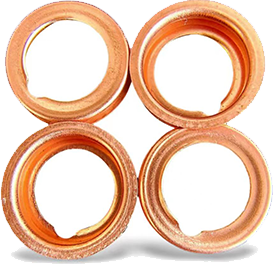oil filter bracket gasket
Understanding the Importance of Oil Filter Bracket Gaskets
In the realm of automotive maintenance and engineering, few components are as vital as the oil filter bracket gasket. This seemingly small part plays a significant role in maintaining the efficiency and longevity of an engine. Understanding its function, signs of wear, and proper maintenance can save vehicle owners time and money while ensuring their engines run smoothly.
What is an Oil Filter Bracket Gasket?
An oil filter bracket gasket is a sealing component located between the oil filter and its mounting bracket. It serves as a barrier that prevents oil from leaking during the filtration process. Typically made from materials like rubber, silicone, or other composites, these gaskets are designed to withstand high temperatures and resist oil degradation.
The Role of the Gasket in Engine Performance
The primary function of the oil filter bracket gasket is to create a tight seal. This seal is essential for maintaining oil pressure within the engine, which is crucial for lubricating moving parts and facilitating the smooth operation of the engine. A compromised gasket can lead to oil leaks, which can result in lower oil levels, reduced lubrication, and ultimately engine damage.
Moreover, the oil filter itself plays a crucial role in trapping contaminants and impurities from the engine oil. If the gasket fails, not only does this put the engine at risk for overheating and excessive wear, but it also compromises the oil filter's effectiveness. A clean and functional oil filter is essential for the overall health of the engine.
Signs of a Failing Oil Filter Bracket Gasket
Recognizing the early warning signs of a failing oil filter bracket gasket can prevent more serious issues down the line. Common indicators include
oil filter bracket gasket

1. Oil Leaks The most obvious sign is the presence of oil spots or puddles under the vehicle. If oil is consistently leaking from the area where the oil filter is mounted, it is likely that the gasket has failed. 2. Low Oil Levels Frequent checks might reveal that oil levels are dropping faster than expected. This can be a sign of a leak caused by a worn or damaged gasket.
3. Engine Overheating A drop in oil pressure due to leaks can lead to increased friction and heat, which may cause the engine to overheat.
4. Unusual Noises If the engine starts making rattling or knocking noises, it could be a sign that lubricating oil is not circulating properly, potentially due to gasket failure.
Maintenance and Replacement
Maintaining the oil filter bracket gasket may not seem like a priority, but it is essential for ensuring the efficiency of engine operation. It is advisable to replace the gasket whenever the oil filter is changed, as this will help prevent potential leaks. Additionally, regular oil changes are crucial for keeping engine components, including gaskets, in good condition.
When replacing an oil filter bracket gasket, it is important to follow proper installation procedures. Ensure that the old gasket is completely removed, as remnants can cause improper sealing. Applying a small amount of oil to the new gasket can help ensure a tight seal and prevent damage during installation.
Conclusion
The oil filter bracket gasket may be a small component, but its significance in the overall functioning of an engine cannot be overstated. Regular checks and maintenance can prevent leaks, ensure proper oil circulation, and ultimately prolong engine life. For vehicle owners, understanding the importance of this gasket is an essential part of maintaining their vehicle's health and performance. Whether you are a seasoned mechanic or an everyday driver, being aware of the signs of wear and the importance of timely replacement can make a significant difference in your vehicle’s operation.
-
Seal 12x20x5: Precision Radial Shaft Seals for Industrial Reliability
News Nov.24,2025
-
Seal 12x18x5: Essential Guide to Specifications, Applications & Vendors
News Nov.24,2025
-
Understanding Seal 12 20 5: Applications, Specifications & Industry Insights
News Nov.23,2025
-
Durable Oil Seal 85x110x12 – Reliable Sealing Solutions for Industry
News Nov.23,2025
-
Durable and Precise Oil Seal 75x95x10 for Efficient Machinery | YJM Seal
News Nov.22,2025
-
Durable Oil Seal 75x100x10 for Reliable Industrial Performance | YJM Seal
News Nov.22,2025
-
High-Quality Oil Seal 65x90x10 | Durable & Reliable Sealing Solutions
News Nov.22,2025
Products categories















